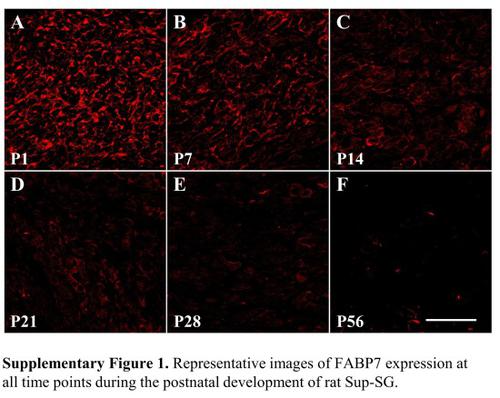当前位置:
X-MOL 学术
›
Brain Res.
›
论文详情
Our official English website, www.x-mol.net, welcomes your feedback! (Note: you will need to create a separate account there.)
Changes in the expression of satellite glial cell-specific markers during postnatal development of rat sympathetic ganglia
Brain Research ( IF 2.9 ) Pub Date : 2024-02-12 , DOI: 10.1016/j.brainres.2024.148809 Huu Son Nguyen , Seong Jun Kang , Sohyun Kim , Byung Ho Cha , Kyu-Sang Park , Seong-Woo Jeong
Brain Research ( IF 2.9 ) Pub Date : 2024-02-12 , DOI: 10.1016/j.brainres.2024.148809 Huu Son Nguyen , Seong Jun Kang , Sohyun Kim , Byung Ho Cha , Kyu-Sang Park , Seong-Woo Jeong

|
The sympathetic ganglia represent a final motor pathway that mediates homeostatic “fight and flight” responses in the visceral organs. Satellite glial cells (SGCs) form a thin envelope close to the neuronal cell body and synapses in the sympathetic ganglia. This unique morphological feature suggests that neurons and SGCs form functional units for regulation of sympathetic output. In the present study, we addressed whether SGC-specific markers undergo age-dependent changes in the postnatal development of rat sympathetic ganglia. We found that fatty acid-binding protein 7 (FABP7) is an early SGC marker, whereas the S100B calcium-binding protein, inwardly rectifying potassium channel, Kir4.1 and small conductance calcium-activated potassium channel, SK3 are late SGC markers in the postnatal development of sympathetic ganglia. Unlike in sensory ganglia, FABP7 + SGC was barely detectable in adult sympathetic ganglia. The expression of connexin 43, a gap junction channel gradually increased with age, although it was detected in both SGCs and neurons in sympathetic ganglia. Glutamine synthetase was expressed in sensory, but not sympathetic SGCs. Unexpectedly, the sympathetic SGCs expressed a water-selective channel, aquaporin 1 instead of aquaporin 4, a pan-glial marker. However, aquaporin 1 was not detected in the SGCs encircling large neurons. Nerve injury and inflammation induced the upregulation of glial fibrillary acidic protein, suggesting that this protein is a hall marker of glial activation in the sympathetic ganglia. In conclusion, our findings provide basic information on the profiles of specific markers for identifying sympathetic SGCs at different stages of postnatal development in both healthy and diseased states.
中文翻译:

大鼠交感神经节出生后发育过程中卫星胶质细胞特异性标志物表达的变化
交感神经节代表了调节内脏器官稳态“战斗和逃跑”反应的最终运动通路。卫星胶质细胞(SGC)形成靠近神经元细胞体和交感神经节突触的薄被膜。这种独特的形态特征表明神经元和 SGC 形成调节交感神经输出的功能单位。在本研究中,我们探讨了 SGC 特异性标记物在大鼠交感神经节出生后发育中是否经历年龄依赖性变化。我们发现脂肪酸结合蛋白7(FABP7)是早期SGC标志物,而S100B钙结合蛋白、内向整流钾通道Kir4.1和小电导钙激活钾通道SK3是晚期SGC标志物。交感神经节的出生后发育。与感觉神经节不同,FABP7 + SGC 在成人交感神经节中几乎检测不到。尽管在 SGC 和交感神经节神经元中均检测到连接蛋白 43(间隙连接通道)的表达随着年龄的增长而逐渐增加。谷氨酰胺合成酶在感觉 SGC 中表达,但在交感 SGC 中不表达。出乎意料的是,交感神经 SGC 表达水选择性通道水通道蛋白 1,而不是水通道蛋白 4(一种全神经胶质标记物)。然而,在包围大神经元的 SGC 中未检测到水通道蛋白 1。神经损伤和炎症诱导神经胶质原纤维酸性蛋白的上调,表明该蛋白是交感神经节中神经胶质激活的霍尔标志物。总之,我们的研究结果提供了有关特定标记物概况的基本信息,用于识别健康和患病状态下出生后发育不同阶段的交感神经细胞。
更新日期:2024-02-12
中文翻译:

大鼠交感神经节出生后发育过程中卫星胶质细胞特异性标志物表达的变化
交感神经节代表了调节内脏器官稳态“战斗和逃跑”反应的最终运动通路。卫星胶质细胞(SGC)形成靠近神经元细胞体和交感神经节突触的薄被膜。这种独特的形态特征表明神经元和 SGC 形成调节交感神经输出的功能单位。在本研究中,我们探讨了 SGC 特异性标记物在大鼠交感神经节出生后发育中是否经历年龄依赖性变化。我们发现脂肪酸结合蛋白7(FABP7)是早期SGC标志物,而S100B钙结合蛋白、内向整流钾通道Kir4.1和小电导钙激活钾通道SK3是晚期SGC标志物。交感神经节的出生后发育。与感觉神经节不同,FABP7 + SGC 在成人交感神经节中几乎检测不到。尽管在 SGC 和交感神经节神经元中均检测到连接蛋白 43(间隙连接通道)的表达随着年龄的增长而逐渐增加。谷氨酰胺合成酶在感觉 SGC 中表达,但在交感 SGC 中不表达。出乎意料的是,交感神经 SGC 表达水选择性通道水通道蛋白 1,而不是水通道蛋白 4(一种全神经胶质标记物)。然而,在包围大神经元的 SGC 中未检测到水通道蛋白 1。神经损伤和炎症诱导神经胶质原纤维酸性蛋白的上调,表明该蛋白是交感神经节中神经胶质激活的霍尔标志物。总之,我们的研究结果提供了有关特定标记物概况的基本信息,用于识别健康和患病状态下出生后发育不同阶段的交感神经细胞。



























 京公网安备 11010802027423号
京公网安备 11010802027423号